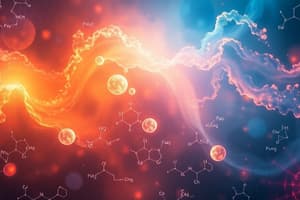Podcast
Questions and Answers
What is formula mass?
What is formula mass?
Formula mass is the average mass of a molecule of a compound, referred to as a formula unit.
What is the formula mass calculation method?
What is the formula mass calculation method?
(The number of one type of atom in the compound multiplied by that atom's atomic weight) plus other atoms multiplied by their atomic weights.
What does 'amu' stand for?
What does 'amu' stand for?
Atomic mass units.
Formula mass is the mass of a single element.
Formula mass is the mass of a single element.
What are molar mass units?
What are molar mass units?
How do you calculate the amount of molecules of a compound in one mole?
How do you calculate the amount of molecules of a compound in one mole?
What is mass percent?
What is mass percent?
What is the formula for mass percent?
What is the formula for mass percent?
How do you find the empirical formula from experimental data?
How do you find the empirical formula from experimental data?
Combustion analysis can only be used for compounds that contain carbon and hydrogen.
Combustion analysis can only be used for compounds that contain carbon and hydrogen.
What is the dilution equation?
What is the dilution equation?
What is molarity?
What is molarity?
What is the major component of a solution called?
What is the major component of a solution called?
Sugar dissolves in water by breaking into constituent atoms.
Sugar dissolves in water by breaking into constituent atoms.
What do you call substances that dissolve in water to conduct electricity?
What do you call substances that dissolve in water to conduct electricity?
What are compounds that do not break apart when dissolved in water called?
What are compounds that do not break apart when dissolved in water called?
Flashcards are hidden until you start studying
Study Notes
Formula Mass and Calculation
- Formula mass represents the average mass of a molecule, also referred to as the formula unit.
- Calculation of formula mass involves multiplying the number of each type of atom in a compound by its atomic weight and summing these products.
- Formula mass is often expressed in atomic mass units (amu).
Moles and Molecular Mass
- Molar mass is expressed in grams per mole (g/mol).
- To calculate the number of molecules in one mole of a compound, divide the mass of the sample by its molar mass and multiply by Avogadro's number.
- Mass percent indicates the contribution of a specific atom within a compound.
Mass Percent Calculation
- To find mass percent of an element:
- Determine the molar mass of the element.
- Divide by the total molar mass of the compound and multiply by 100%.
Conversion Factors
- Conversion factors in chemical formulas can help in determining the number of moles of atoms and their corresponding masses in a compound.
- Example: In CCl2F2, there is 1 mole of carbon, 2 moles of chlorine, and 2 moles of fluorine.
Moles and Mass Calculations
- To find moles of Cl in CCl2F2:
- 38.5 moles of CCl2F2 contains 77 moles of Cl upon calculation.
- To find grams of Cl in a given mass of CCl2F2, use molecular weight and conversion factors.
Chemical Formulas from Data
- Determining a chemical formula from experimental data involves converting grams of elements to moles, adjusting ratios based on the smallest molecular number.
- Rules for rounding during this process include rounding down for decimals less than 0.2, rounding up for more than 0.8, and finding a common number for intermediate values.
Molecular and Empirical Formulas
- An empirical formula can be determined from experimental data, while the molecular formula can be derived using the empirical formula and molar mass.
- Example: Fructose has the empirical formula CH2O and a molecular formula of C6H12O6, calculated based on its molar mass.
Combustion Analysis
- Combustion analysis is a method for obtaining empirical formulas, particularly for compounds with carbon and hydrogen.
- In combustion, carbon converts to CO2 and hydrogen to H2O; any other elements are determined by subtracting their mass from the sample.
Balancing Chemical Equations
- Writing and balancing chemical equations involves starting with a skeletal equation and balancing complex molecules before free elements.
- Use coefficients to ensure a balanced equation, and avoid fractional coefficients by multiplying through by the denominator if necessary.
Stoichiometry and Limiting Reactant
- Stoichiometry involves using mole ratios to convert between reactants and products.
- A limiting reactant is the one that produces the least amount of product, directly impacting theoretical yield, which is the maximum possible product based on the limiting reactant.
Solutions and Concentrations
- Solutions are homogeneous mixtures of solute and solvent; solute is the minor component, while solvent is the major component.
- Molarity (M) quantifies solution concentration, defined as mol of solute per liter of solution.
Dilution and Stoichiometry
- The dilution equation (M1V1 = M2V2) relates the molarity and volume of concentrated and diluted solutions.
- For stoichiometric calculations, volume and molarity must be considered to react completely with specified amounts of different solutions.
Electrolytes and Solutions
- Electrolytes are substances that, when dissolved, result in solutions capable of conducting electricity, distinguished as strong or weak based on ionization.
- Ionic compounds dissociate into ions in water, allowing for conduction of electricity, while covalent compounds like sugar remain intact as non-electrolytes.
Studying That Suits You
Use AI to generate personalized quizzes and flashcards to suit your learning preferences.



